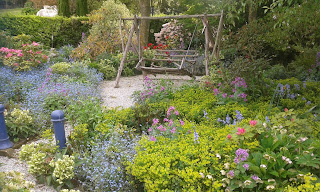SEPTEMBER, the season of new beginnings and some beautiful early spring days experienced here in North Otago over the last week to encourag buds to swell and burst, birds get busy buildings nests and new born lambs enjoy a warm welcome.
Slower to start here this year but now growth is moving I have been re potting cuttings that have been making roots during winter, fresh potting mix to sustain new leaf growth and flowers will ensure good results. Liquid fertilizer once a week can start now as well, I use a watering can, when leaves are dry of dew. Pansies, primulas, pollyanthus, sweet peas, lupins, all new seasons bedding plants respond feeding now.
I am sure every gardener enjoys trying new plants and colour combinations, now is the perfect time to sow seeds for summer flowering, I have sown some under glass and some just under frost cloth, better still in a glass or tunnel house if you have one, germination is fast when days are bright, warm and lengthening so we are off to a good start this spring.
With very wide perennial boarders insisting on growing couch, biddy- bid, and chick-weed, I try to get rid of them now while the flowering plants are still low and with ground still soft weed pulling is easy. While doing this weeding I can see what needs attention like delphiniums needing staked to give support while growing, removing mulch from around iris rhizomes and peony rose crowns and removing self sown plants and natives before they settle in.
The width of a flower garden can be reduced by planting a spreading front boarder, a front boarder of the same plant will also formalize a busy mixed garden and cut down on weeding and bird scratching.
Boarder plant suggestions, lambs ear, purple sage, aubretia, dwarf agapantha, catmint, mondo grass,violas, Armeria maritima, commonly known as thrift and in very wide borders ground cover erica's will spread a meter and add colour during winter. A lot of the mentioned plants will already be growing in gardens so can be broken up to spread along a border.
Roses are pushing out new shoots here, if you haven't pruned yet do it now before they leaf up and give them a dressing of rose food or compost if you have some, they are gearing up for a come back!
Dahlias, a little early for planting tubers yet but the addition of dolomite lime where they are to be planted will sweeten the ground ready for planting next month.
Deciduous magnolias are pushing off furry bud covers, camellia's and rhododendrons are bursting into colour, all plants, shrubs and trees will respond to feeding now the sap is well up and buds are swelling. Liquid feed all perennial and bedding plants making growth and use a good general fertiliser for trees and shrubs to help them along. Azaleas and tulips are the exception, azaleas like fed after flowering and tulips store enough food in the bulb for their requirements. if you load them up with more they will grow more leaf and hide the blooms. (No feeding for Australian or South African shrubs such as leucodendron, protea, waratah and grevillea.)
Lawns:
Prepare ground for sowing new lawns, here on the coast ground will soon be warm enough to get a strike, sow seed thickly in spring to beat the annual weeds. Once spring mowing starts keep the mower blades up to allow grass to thicken. Remove moss with sulphate of iron watered on with a watering can and raked out when it has turned black. Feed lawns just before or during rain and they will stay lush.
Vegetables:
Here on the coast sow lettuce seed and plant lettuce plants at two week intervals along with all green leaf veg on offer for sale and peas, board beans,( other beans need the soil a little warmer). I was once told to plant each bean with a little pot ash to help with rust problems, they still get a little rust but I think that's probably due to them getting too dry between watering's. I will need to secure them with wire stakes before the strong winds arrive.
New potatoes: Prepare ground for planting sprouted seed potatoes.
Strawberries: still haven't prepared the strawberry bed yet, maybe this weekend.!
Fruit: Almost peach / nectarine bud burst, if you need to deal to leaf curl, this is a fungal disease which over winters in tree bark and around buds, leaves become curled and deformed with warty growths. Just before bud burst spray with liquid copper and once again after petal fall. If only a few leaves are affected remove and destroy. Success in holding off leaf curl has been achieved by spraying unaffected leaves with vaporgard ensuring both sides of the leaves are covered, two days later give the tree and surrounding soil a spray with condys crystals. Vaporgard has a UV shield aspect protecting chlorophyll allowing leaves to produce more energy from the sun.
Below is a helpful NZ planting calendar you can down load.
Cheers, Linda.





